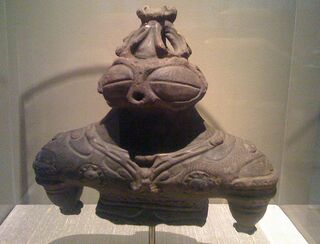Dogu
Revision as of 00:07, 10 August 2016 by LordAmeth (talk | contribs) (Created page with "right|thumb|320px|A late [[Jomon period|Jômon period earthenware ''dogû'' figure on display at LACMA.]] *''Japanese'': 土偶 ''(doguu)'' ''Dogû'' are [[...")

A late Jômon period earthenware dogû figure on display at LACMA.
- Japanese: 土偶 (doguu)
Dogû are earthenware figures which have been found in considerable numbers in Jômon Period sites.
Little is known about the humanoid figures, though scholars have speculated that they may have served an apotropaic purpose, guarding against evil spirits, illness, or injury. Markings on the figures have sometimes been interpreted as indicating that Jômon era people were heavily tattooed.
Roughly 1000 dogû have been found. Most seem to have been intentionally broken and discarded as part of some sort of ritual use.
References
- "Two figurines," British Museum gallery label.[1]